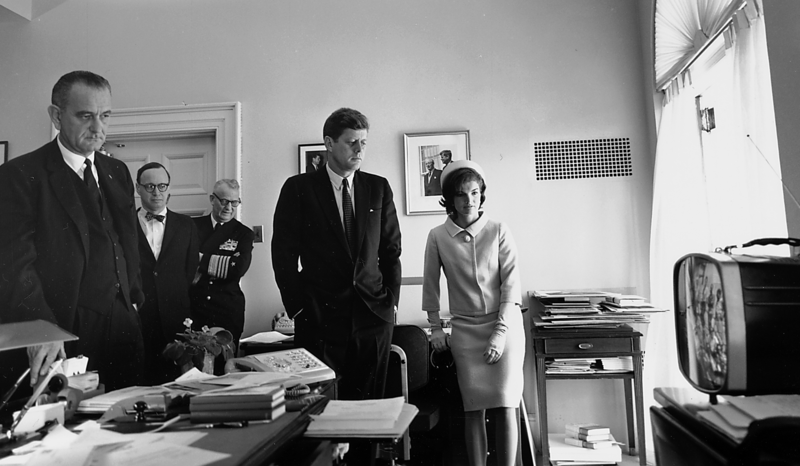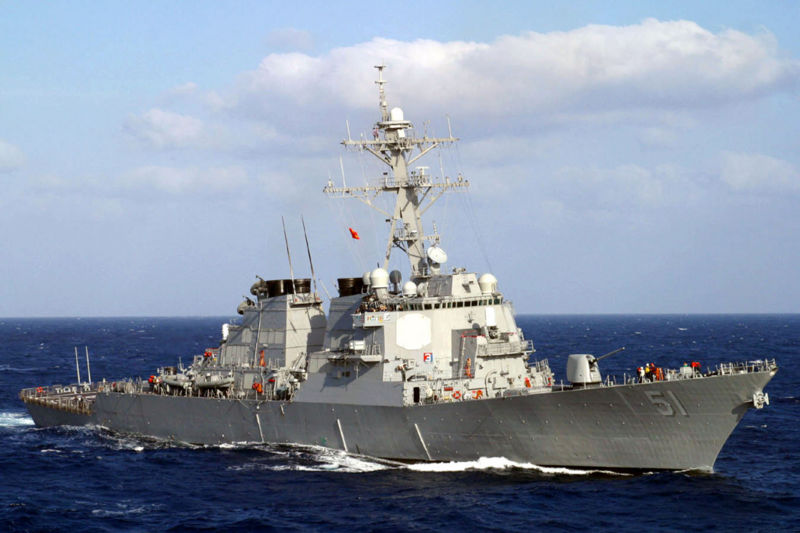<Back to Index>
- Zoologist George Albert Boulenger, 1858
- Novelist Miguel Ángel Asturias Rosales, 1899
- Admiral of the U.S. Navy Arleigh Albert "31-knot" Burke, 1901
PAGE SPONSOR
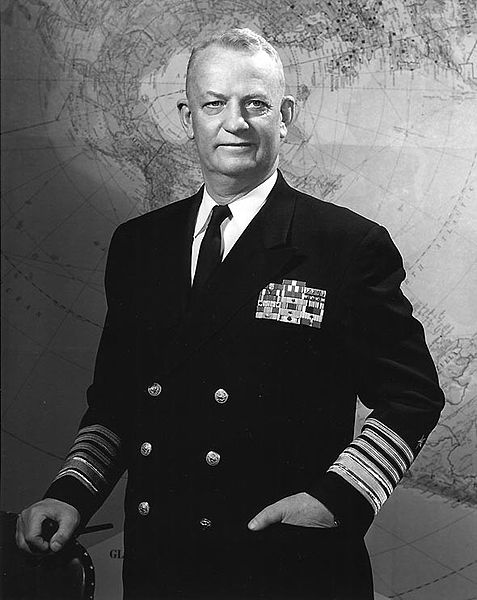
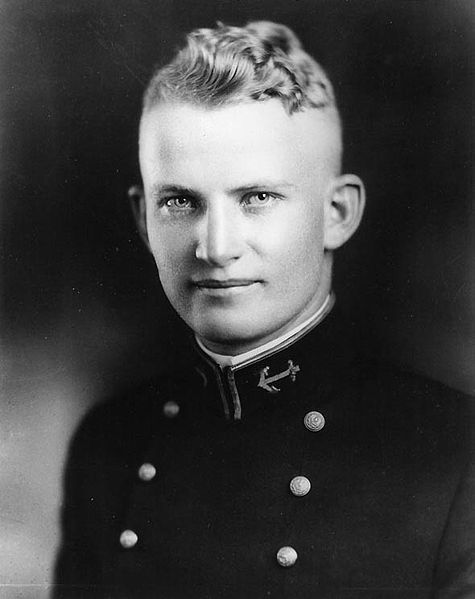
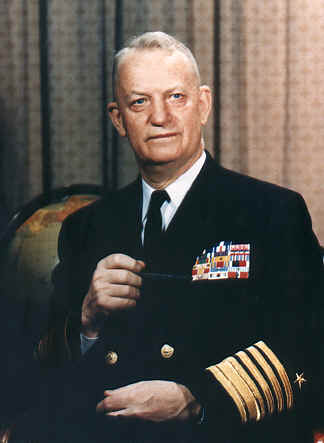
Admiral Arleigh Albert '31-knot' Burke (October 19, 1901 – January 1, 1996) was an admiral of the United States Navy who distinguished himself during World War II and the Korean War, and who served as Chief of Naval Operations during the Eisenhower and Kennedy administrations.
Burke was born far from the sea, in Boulder, Colorado. On June 8, 1923, he graduated from the United States Naval Academy, was commissioned as an Ensign in the United States Navy, and married Miss Roberta Gorsuch of Washington, D.C.
Over the next 18 years, Burke prepared himself for combat, serving in battleships and destroyers, and earning a Master of Science in Engineering at the University of Michigan. When World War II came, he found himself, to his great disappointment, in a shore billet at the Naval Gun Factory in Washington, D.C. After persistent effort on his part, he received orders to join the fighting in the South Pacific. Burke would spend the remainder of the war in the South Pacific. He successively commanded Destroyer Division 43, Destroyer Division 44, Destroyer Squadron 12, and Destroyer Squadron 23. The latter squadron, known as the "Little Beavers", covered the initial landings in Bougainville in November 1943, and fought in 22 separate engagements during the next four months. During this time, the Little Beavers were credited with destroying one Japanese cruiser, nine destroyers, one submarine, several smaller ships, and approximately 30 aircraft. Burke's standing orders to his task force were, "Destroyers to attack on enemy contact WITHOUT ORDERS from the task force commander."
He usually pushed his destroyers to just under boiler - bursting speed, but while en route to a rendezvous prior to the Battle of Cape St. George, a boiler casualty limited his squadron to 31 knots, rather than the 34 they were otherwise capable of. Thereafter, his nickname was "31-knot Burke," originally a taunt, later a popular symbol of his hard - charging nature.
In March 1944, Burke was promoted to Chief of Staff to the Commander Fast Carrier Task Force 58, which was commanded by Admiral Marc Mitscher. While serving with this famed carrier force, Burke was promoted to the temporary rank of Commodore, and participated in all the force's naval engagements until June 1945, shortly before the surrender of Japan. He was aboard both USS Bunker Hill (CV-17) and USS Enterprise (CV-6) when they were hit by Japanese kamikaze aircraft during the Okinawa campaign.
After
the end of the war, Burke reverted to his permanent rank of Captain and
continued his naval career by serving in a number of capacities,
including once more as Admiral Mitscher's chief of staff, until the
latter's death in 1947. Burke then took command of the USS Huntington (CL-107) for a cruise down the east coast of Africa. He was promoted to Rear Admiral in 1949 and served as Navy Secretary on the Defense Research and Development Board.
At the outbreak of the Korean War, Admiral Forrest Sherman, then Chief of Naval Operations, ordered Burke to duty as Deputy Chief of Staff to Commander Naval Forces, Far East. From there, he assumed command of Cruiser Division Five, and, in July 1951, was made a member of the United Nations Truce Delegation which negotiated with the Communists for military armistice in Korea. After six months in the truce tents, he returned to the Office of Chief of Naval Operations where he served as Director of Strategic Plans Division until 1954.
In April 1954, he took command of Cruiser Division Six, then moved in January 1955 to command Destroyer Force Atlantic Fleet. In August 1955, Burke succeeded Admiral Robert B. Carney as Chief of Naval Operations. At the time of his appointment as Chief of Naval Operations, Burke was still a Rear Admiral, Upper Half (Two Star) and was promoted over the heads of many Flag Officers who were senior to him. Admiral Burke had never served as a Vice Admiral (Three Star), so he was promoted two grades at the time of his appointment as CNO.
Admiral Burke served an unprecedented three terms as CNO. He served at a critical time in world history, the depths of the Cold War. The facts that he was relatively young compared to other Flag Officers at the time, and was an excellent manager and organizer, were keys to his success. He supported the touchy Adm. Hyman Rickover in the development of a nuclear Navy. More directly, he promoted the Polaris missile program at a time when others in the Navy were very skeptical of the idea of a missile launched from a submarine.
Admiral Burke as CNO was intimately involved in the Eisenhower administration discussions of "how much is enough?", as to the number of US nuclear submarines needed for deterrence. Burke argued that a force of around 40 Polaris submarines (each with 16 missiles) was a reasonable answer. Burke further argued that land-based missiles and bombers were vulnerable to attack, which made the U.S. - Soviet nuclear balance dangerously unstable. By contrast, nuclear submarines were virtually undetectable and invulnerable. He was very critical of "hair trigger" or "launch on warning" nuclear strategies, and he warned that such strategies were "dangerous for any nation."
Earlier, Admiral Burke was involved in the "Revolt of the Admirals", a near mutiny by the leaders of the Navy in the late 1940s, and was saved from being fired by the intervention of President Harry S. Truman. His terms as CNO were times of growth and progress in the Navy. Upon completing his third term, he was transferred to the Retired List on August 1, 1961.
Burke died on January 1, 1996, at National Naval Medical Center in Bethesda, Maryland. He was 94 years old. He is buried at the United States Naval Academy Cemetery, in Annapolis, Maryland, according to his wishes, his headstone simply bears a one word epitaph, Sailor.
USS Arleigh Burke (DDG-51), the lead ship of her class of Aegis - equipped guided missile destroyers, was commissioned in his honor in 1991, when he was still alive.
Admiral Burke received numerous combat awards during his forty-two years in the Navy including the Navy Distinguished Service Medal, Navy Cross, Legion of Merit, and the Purple Heart. None were more cherished than two awards which came early in his career. In 1928, while serving aboard USS Procyon (AG-11), he was commended for the "rescue of shipwrecked and seafaring men," and in 1939, in his first command, USS Mugford (DD-389), he was commended when his destroyer won the fleet gunnery trophy with the highest score in many years. His ship also stood third in engineering competition and high in communication competition.
Admiral Burke, himself of Swedish descent, was the senior representative of the United States of America on the funeral of King Gustaf VI Adolf of Sweden in 1973.
The character portrayed by Carroll O'Connor in the 1965 film, In Harm's Way, starring John Wayne, was modeled after Admiral Burke.
The Assisted Living section of the Vinson Hall Retirement Community in McLean, Virginia is named the Arleigh Burke Pavilion in his honor. The USS Arleigh Burke (DDG-51), a guided - missile destroyer of the United States Navy and lead ship of her class,
was named in his honor. The class is one of the most advanced in
service and is the only destroyer class currently in active US Navy
service. An elementary school was named in his honor in Boulder; it was closed in 1982. Thunderbird Park of Boulder, CO was renamed Admiral Arleigh A. Burke Memorial Park in 1997. In October 2001, a dedication of the memorial was held, featuring
a 12-foot, 26,000-pound anchor from a World War II destroyer, a
memorial wall containing a bronze relief sculpture of the admiral and a
plaque with his biography. The
Navy annually awards the Arleigh Burke Fleet Trophy to "the ship or
aircraft squadron from each coast selected for having achieved the
greatest improvement in battle efficiency during the calendar year,
based upon the Battle Efficiency Competition." Winning the Battle "E" is not a prerequisite.
In 1962, Admiral Burke co-founded the Center for Strategic and International Studies (CSIS) in Washington, D.C. with David Abshire.
The
United States Postal Service issued a commemorative stamp pane on
February 4, 2010, honoring distinguished sailors. In addition to
Admiral Burke, the other persons on the stamp pane were Admiral William S. Sims, Lieutenant Commander John McCloy, and Officer’s Cook Third Class Doris Miller.
